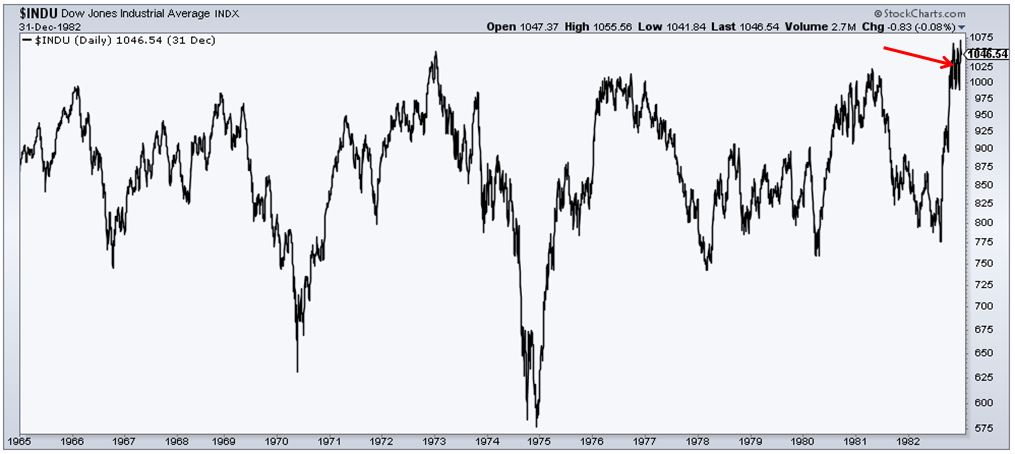This week in 1982 marked a major milestone in the history of the stock market. The Dow Jones Industrial Average closed above 1,000- its highest levels in nearly a decade- and it was on the precipice of saying sayonara to a 16-year bear market. A new secular bull market was right around the corner and the S&P 500 would go on to advance 1650% over the next 17 years, or 18.3% a year.

I looked through the New York Times archive to see what they were saying this week. Nothing too surprising really, it’s not as if I was expecting to see something like “goodbye bear, hello bull” or “put all of your money and all that you can borrow into the stock market right now.” Instead, what was printed is exactly what you would expect to see at the tail end of a long bear market, bad news and lots of skepticism.
As the stock market soared, seemingly out of nowhere, economists were left scratching their heads. This quote really sums up the general attitude at the time.
“The question now for economists is what produced these wonders at a time of almost unrelievedly bad economic news.”
Here are some more headlines and excerpts from this week in 1982, enjoy.
October 9, 1982
“Yesterday, the Dow jumped 20.88 points, finishing at 986.85, just 13.15 points away from the 1,000 mark. The last time it closed that high was on June 23, 1981, at 1,006.66. The ”Reagan high,” as it was dubbed on Wall Street, came on April 27 of last year, when the Dow finished at 1,024.05.”
“Since Aug. 12, the Dow has climbed 209.93 points, or 27 percent. Never before has the average registered a point gain of this magnitude in a two-month period.”
October 9, 1982- WEEK IN BUSINESS; A SURGE TO 10.1% IN UNEMPLOYMENT
“America’s unemployment rate in September crossed the double-digit point for the first time since 1940, to 10.1 percent, the Labor Department reported Friday. Nearly 11.3 million people were unemployed – 450,000 higher than in August and a rise of more than 3 million in the last 12 months.”
“Retail sales were sluggish in September, the nation’s major retailers reported. Of the five largest, two reported sales declines, while the other three – including Sears, the industry leader – said sales rose less than 3 percent.”
October 9, 1982- DOW SOARS 20.88 MORE,TO 986.85
“Analysts said that many of the institutions had invested cautiously in the market’s upswing during mid-August, when interest rates first started to decline, and through September, when the Dow soared more than 150 points, and were now apparently fearful of missing out in the latest rally.”
October 10, 1982
“With unemployment still rising, the stubborn stock market rally that began in August escalated last week and the bond market strengthened as investors anticipated lower interest rates.”
October 11, 1982- Volcker’s Talk Stirs Cautious Optimism
“Consumers remain conservative in their buying habits.”
October 11, 1982- Further Rate Drops Predicted
“Hopes that the central bank will encourage lower rates was also the springboard for the stock market’s soaring gains last week. The Dow Jones industrial average raced ahead 79.11 points, finishing at 986.85. It was the second-biggest weekly advance on record.”
“Despite last week’s stunning advance – the Dow has climbed nearly 210 points, or 27 percent, in less than two months -optimism still reigns.”
October 11, 1982- THE FED AND ITS CREDIT DILEMMA; Economic Analysis
Legend has it that one day long ago a cowboy stumbled upon one of nature’s most awesome sights, the Grand Canyon. ”Wow,” the cowboy is supposed to have exclaimed. ”Something sure happened here.” Last week something spectacular happened in the financial markets. The stock market rose 79 points, trading surged to a one-day record of 147 million shares on Thursday and interest rates plunged until one Treasury bond now carries a price fully one-third higher than the face value at which it will eventually be paid off….The question now for economists is what produced these wonders at a time of almost unrelievedly bad economic news.”
“The double-digit unemployment – 10.1 percent, the highest in 42 years – was announced Friday.”
October 11, 1982- BUSINESS DIGEST; MONDAY, OCTOBER 11, 1982; The Economy
“The economic situation still worries business leaders, despite plummeting interest rates and the resulting run-up in the stock and credit markets. Business Council members remain concerned about Federal budget deficits and spending, illiquidity and unemployment. “
Source:

